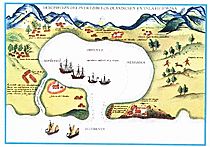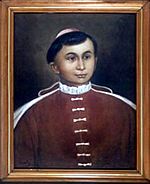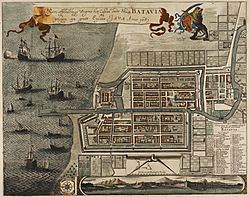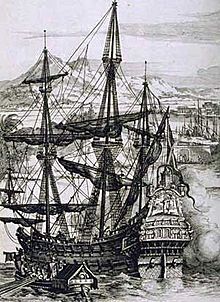Battles of La Naval de Manila facts for kids
Quick facts for kids Battle of La Naval de Manila, Battle of Manila Bay |
|||||||
|---|---|---|---|---|---|---|---|
| Part of the Eighty Years' War | |||||||
|
|||||||
| Belligerents | |||||||
| Commanders and leaders | |||||||
|
|
|
||||||
| Strength | |||||||
|
8 ships
|
35 ships
470 guns (est.) |
||||||
| Casualties and losses | |||||||
| 15 dead |
500 dead (est.) |
||||||
The Battles of La Naval de Manila or Battle of Manila Bay were a series of five important naval battles. They took place in 1646 in the waters around the Spanish East Indies, which is now the Philippines. In these battles, the forces of the Spanish Empire fought off several attempts by the Dutch Republic to invade Manila. This happened during the Eighty Years' War between Spain and the Netherlands.
The Spanish forces, which included many local volunteers, used only two (and later three) large trading ships called Manila galleons, one galley, and four smaller boats called brigantines. They managed to defeat a much larger Dutch fleet of nineteen warships. The Spanish forces caused a lot of damage to the Dutch ships, forcing the Dutch to give up their plan to invade the Philippines.
The Spanish soldiers believed their victories against the Dutch invaders were due to the help of the Virgin Mary. She was honored under the title of Our Lady of La Naval de Manila. On April 9, 1652, the Archdiocese of Manila officially declared these five sea battles a miracle. This led to the yearly celebrations of Our Lady of La Naval de Manila, which still happen today.
Contents
Why the Battles Happened
Early Fights Between Spain and the Dutch
The Dutch wanted to find new trade routes to Asia. When they reached the Philippines, they aimed to control sea trade in Southeast Asia. Since they were at war with Spain, they acted like pirates. They attacked the coasts around Manila Bay and stopped trade ships from China and Japan. This was an attempt to cut off Spain's trade with East Asia.
The first Dutch fleet to reach the Philippines was led by Olivier van Noort in 1600. Later, other Dutch fleets tried to attack Manila in 1609 and 1616. But the Spanish forces, led by governors like Juan de Silva and commanders like Juan Ronquillo, fought them off. The Dutch ships were often damaged, and their attacks failed.
From 1640 to 1641, the Dutch tried to capture Spanish merchant ships coming from Mexico. However, these ships were warned by a system of fire-signals and took different routes, escaping safely.
Dutch Plan to Invade the Philippines
After failing to stop Spain's trade in Asia, the Dutch decided to take over the Philippines. They believed they were strong enough. In 1642, they conquered a Spanish settlement in Formosa. After this, the Dutch were very keen to attack Manila. They knew the city's defenses were weak, and Spain was busy fighting wars in Europe.
A Dominican priest, Fr. Juan de los Angeles, who was a prisoner of the Dutch, said that the Dutch talked about nothing else but taking Manila. He also described the large Dutch forces in places like Jakarta in Indonesia and Formosa. He said they had "more than one hundred and fifty ships" ready for battle.
Manila's Difficult Situation
The Philippines was already facing many problems when the Dutch planned their invasion:
- Volcanic eruptions and food shortages happened between 1633 and 1640.
- Wars against Muslim groups and a Chinese rebellion (Sangley Rebellion) in 1639-1640 had cost many lives and resources.
- Many Spanish ships were lost or wrecked between 1638 and 1639. This hurt the Manila–Acapulco trade and reduced Manila's naval power.
- After taking Formosa in 1642, the Dutch sent ships to wait for relief ships coming to the Philippines. They also attacked trading vessels from China.
The new Spanish governor-general, Diego Fajardo Chacón, arrived in 1644. He found the islands very weak in naval strength. He quickly sent two galleons, the Nuestra Señora dela Encarnación (Encarnación) and Nuestra Señora del Rosario (Rosario), to Mexico to get new supplies.
Bad Events in 1645
- Death of the Archbishop: In July 1645, the new archbishop of Manila, Don Fernando Montero de Espinosa, died on his way to Manila. The people of Manila were very sad because they needed a strong religious leader.
- The San Andres Earthquake: On November 30, 1645, a huge earthquake hit Manila. It destroyed about 150 large buildings and killed many people. Five days later, another strong earthquake hit, destroying what was left. The earthquakes also damaged villages and caused rivers to flood.
The Main Attack in 1646
The Dutch leaders in New Batavia (Jakarta) decided to launch a major attack on the Philippines. They prepared 18 ships and divided them into three groups:
Dutch Forces
- First Squadron: 5 ships. Their goal was to go to Ilocos and Pangasinan. They wanted to turn the local people against the Spanish and capture trading boats.
- Second Squadron: 7 ships (including 2 fire ships) and 16 smaller boats. They had 800 soldiers. Their main ship had 46 cannons. Their goal was to go to Zamboanga and then to the San Bernardino Strait. They wanted to capture ships coming from Mexico that brought money to Manila.
- Third Squadron: 6 ships. Their main ship had 45 guns. Their goal was to go to Manila to support the other two squadrons. They also wanted to stop any help from Manila going to Ternate and Makassar.
The plan was for these three groups to meet outside Manila Bay after the monsoon season and attack the city.
Spanish Forces
News reached Manila on February 1, 1646, that the first Dutch squadron was in Ilocos and Pangasinan. The Dutch tried to convince the Ilocanos and Pangasinenses to rebel, promising them freedom and no taxes. But when the locals refused, the Dutch robbed their homes. Spanish soldiers arrived and forced the Dutch back to their ships.
Governor Fajardo called a meeting to discuss what to do. Manila had almost no warships. The only ships available were two old Manila-Acapulco galleons, the 800-ton Encarnación and the 700-ton Rosario. These ships had just arrived from Mexico the year before. Even though the Dutch had many more ships, Governor Fajardo decided to prepare these two galleons for battle.
The two galleons were quickly made ready:
| Encarnación | Rosario | |
|---|---|---|
| Role | Capitana (Flagship) | Almiranta (Admiral ship) |
| Cannons | 34 bronze cannons | 30 cannons |
| Soldiers | 200 men | 200 men |
General Lorenzo Ugalde de Orellana was put in charge of the Spanish fleet and became captain of the Encarnación. Sebastian Lopez became the admiral and captain of the Rosario.
The Battles of 1646
First Battle
The Spanish fleet sailed to Mariveles, but the Dutch were not there. The Spanish then went to Bolinao in Lingayen, Pangasinan. On March 15, they saw one Dutch ship, which quickly fled. Later, four more Dutch ships appeared.
The battle started between 2 and 3 PM. The Dutch flagship fired first but missed. The Encarnación fired back, hitting the Dutch flagship and damaging its front. The Dutch then focused their fire on the Rosario, which fired back. The Encarnación fired at all four Dutch ships, causing heavy damage. This forced the Dutch to retreat.
The battle lasted five hours. Around 7 PM, the Dutch ships left in the dark. The Dutch flagship was almost sinking but escaped. The Spanish fleet searched for them but the Dutch disappeared.
The Spanish fleet had only minor damage. No one was killed, and only a few were wounded. The two Spanish galleons had so many cannons and ammunition that they outgunned the Dutch ships.
The two ships stayed in Bolinao for repairs. General Orellana received orders to protect the merchant galleon San Luis, which was expected from Mexico. This ship carried important goods and could be a target for the Dutch.
Naval Siege at Ticao Island In mid-April, the second Dutch squadron entered Philippine waters. They tried to attack Spanish forts but faced strong resistance. News of the Dutch reached the Spanish fleet, which was docked at the Port of San Jacinto in Ticao Island on June 1.
On June 23, the Dutch discovered the Encarnación and Rosario in the port. The Dutch decided to block the harbor entrance with their ships to trap the two galleons.
The Spanish decided not to fight yet to save their ammunition. They wanted to wait for the San Luis. Spanish soldiers secured a nearby hill to prevent the Dutch from using it. The Dutch tried to attack the hill and the galleons, but they failed.
The Dutch and Spanish fleets waited for 31 days for the San Luis to arrive. But it never showed up. The Dutch commander, Antonio Camb, thought the ship had already reached another port. So, the Dutch ended their siege and sailed towards Manila.
Second Battle
On July 25, the Spanish fleet left Ticao. They saw the Dutch squadron sailing towards Manila. The Encarnación and Rosario chased them quickly. They knew Manila was unprotected, as all its cannons had been moved to their ships.
A priest on the Encarnación, Fr. Juan de Cuenca, told the men that God and the Virgin Mary would give them victory and that no one would be killed.
The two Spanish galleons caught up with the seven Dutch warships between Banton and Marinduque on July 28. Before the battle, both General Orellana and Admiral Lopez promised the Virgin of the Rosary that if they won, they would hold a special celebration. They would walk barefoot to her chapel in Santo Domingo church.
The second battle, which was very fierce, began on July 29 around 7 PM. The seven Dutch ships surrounded the Encarnación. The Spanish flagship fought back hard, causing more damage to the Dutch. The Rosario fired from outside the circle, hitting the enemy ships.
At one point, the Encarnación got tangled with the Dutch flagship. This was dangerous because the Dutch could board the Spanish ship. But the Spanish sailors quickly cut the ropes, freeing both ships.
The Dutch tried to blow up the Encarnación with a fire ship. But the Spanish flagship fired continuously, forcing the fire ship away. It then turned to the Rosario, but the Rosario fired ten shots at it. The fire ship caught fire and sank, killing its crew.
The battle lasted until morning, and the Dutch fled. One Dutch sailor from the sunken fire ship was captured. As Fr. de Cuenca had promised, no one was killed on the Encarnación. The Rosario lost five men.
Third Battle
The next day, the Spanish fleet chased the enemy, who now had only six ships. The Spanish cornered the Dutch on July 31, 1646, around 2 PM, between Mindoro and Maestro de Campo Island. This is where the third battle happened.
The Spanish fleet attacked, while the Dutch fought defensively. The cannon fire was very intense. The Dutch tried to disable the Rosario, but it was met with heavy cannon shots.
In desperation, the Dutch sent their last fire ship. It had 30 cannons but no sail, so two other ships towed it. General Orellana ordered his musketeers to fire at the men directing the fire ship. At the same time, his ship's cannons fired at the approaching vessel. The fire ship was badly hit and sank, taking its crew and fireworks to the bottom of the sea.
As the fire ship sank, the Spanish sailors shouted "Ave Maria!" and "Long live the Faith in Christ and the Most Holy Virgin of the Rosary!"
The battle continued until about 6 PM. The Dutch fled again into the night, their flagship badly damaged. The Spanish were overjoyed. They publicly said it was a victory from Our Lady of the Rosary. General Orellana knelt before an image of Our Lady and thanked her.
Governor Fajardo ordered the Spanish fleet to return to Cavite for rest and repairs. After a six-month journey, the victorious fleet reached Cavite in late August. As soon as they landed, the Spanish troops, led by General Orellana, walked barefoot to the Santo Domingo church in Manila. They were welcomed as heroes. General Orellana retired and received a reward, and other officers were promoted.
Fourth Battle
After these victories, the Spanish in Manila thought the Dutch had given up their invasion plan. So, they allowed a new merchant galleon, the San Diego, to sail towards Mexico without any escort ships.
But the Spanish didn't know that three Dutch warships from the third squadron had already entered Philippine waters in September. These Dutch ships were supposed to join the earlier squadrons, but they didn't know those squadrons had already been defeated.
General Cristoval Marquez de Valenzuela, commander of the San Diego, was surprised to find the three Dutch ships near Fortune Island. Seeing that the San Diego was not a warship, the Dutch attacked it fiercely. The San Diego barely escaped and retreated to Mariveles. It then went to Cavite to tell the Governor General about the Dutch presence.
Governor Fajardo immediately ordered a new Spanish fleet to be formed. It now included three galleons (the Encarnación, Rosario, and the San Diego, which was turned into a warship), one galley, and four brigantines. The Encarnación and Rosario remained the flagship and admiral ship.
Changes in Command With General Orellana's retirement, Sebastian Lopez (the former admiral) was promoted to commander-in-chief of the fleet and became the new captain of the Encarnación. Agustin de Cepeda became the admiral and captain of the Rosario.
Governor Fajardo ordered that the promise made during the previous battles be renewed. The practice of praying the Holy Rosary aloud while kneeling before the image of Our Lady was also continued.
On September 16, 1646, the Spanish fleet sailed towards Fortune Island, but the Dutch were not there. Sailing further towards Mindoro, the Spanish saw the Dutch ships between Ambil and Lubang Islands.
The fourth battle began around 4 PM. The wind was against the Spanish, making it hard to get close to the enemy. The two fleets were far apart, so they fired at each other from a long distance for five hours.
Around 9 PM, the current pushed the Rosario towards the enemy. It found itself surrounded by the three Dutch ships. The Encarnación had trouble getting close to help. For four hours, the Rosario fought fiercely against the three Dutch ships, forcing them to retreat and hide near Cape Calavite.
Fifth Battle
The final battle happened on October 4, 1646. General Sebastian Lopez decided to bring the newly built San Diego back to Mariveles because it had some problems. The San Diego was anchored at Mariveles, with the Encarnación guarding it from a distance. The Rosario was carried far away by strong currents.
Seeing that the three Spanish galleons were far from each other, the three Dutch ships decided to attack again. The Dutch ships were large and well-armed. Their flagship had 40 cannons.
General Lopez decided not to move the Encarnación from its position. He waited for the Dutch to come closer. When the Dutch got very close, Lopez ordered the anchor to be raised. The Encarnación fired violently at the three Dutch ships. All four ships were carried by the current away from the San Diego.
The intense firing lasted for four hours. The Encarnación caused severe damage to the enemy, forcing the Dutch to flee again. As the Dutch fled, the wind suddenly stopped. This allowed the galley, commanded by Admiral de Esteyvar, to attack the Dutch flagship, which was stuck without wind. Even though it had fewer guns, the galley fired so fiercely that the Dutch thought they were lost and tried to jump overboard.
The Dutch flagship was almost sinking when the wind returned, helping them escape. The Encarnación and the galley chased them, but the Dutch managed to get away by nightfall. No one was killed on the Spanish galley, but four men died on the Encarnación.
What Happened Next
The victorious Spanish fleet returned to Manila. They again walked barefoot to the shrine of Our Lady of the Rosary in Santo Domingo Church.
On January 20, 1647, the victory was celebrated with a special feast. This included a procession, a Mass, and a parade of the Spanish ships. The city of Manila then promised to celebrate these naval victories every year.
Because the Dutch failed to conquer the Philippines, the islands remained under Spanish rule until 1898. Meanwhile, the Dutch succeeded in establishing their own colonies further south, creating the Dutch East Indies (modern-day Indonesia). The history of the Philippines and Indonesia today is still shaped by these events.
Official Investigations
On April 6, 1647, Father Friar Diego Rodriguez, a Dominican priest, asked the church leaders in Manila to declare that the victories of 1646 were a miracle. He said they were due to the help of the Virgin of the Rosary.
The City Council considered three main points to declare the victories miraculous:
- Only fifteen Spanish soldiers died in total.
- The two main Spanish ships were very old and not strong enough for battle.
- The soldiers prayed the Holy Rosary devoutly and believed their victory came from God through the Virgin Mary.
Declared a Miracle
On April 9, 1652, the church leaders of the Metropolitan Church of Manila officially declared the battles of 1646 to be miraculous.
See also
 In Spanish: Batalla de La Naval de Manila para niños
In Spanish: Batalla de La Naval de Manila para niños





